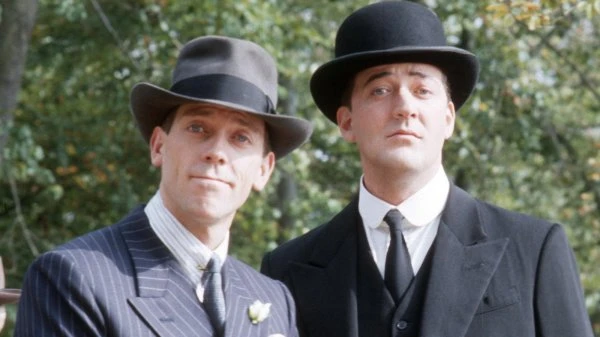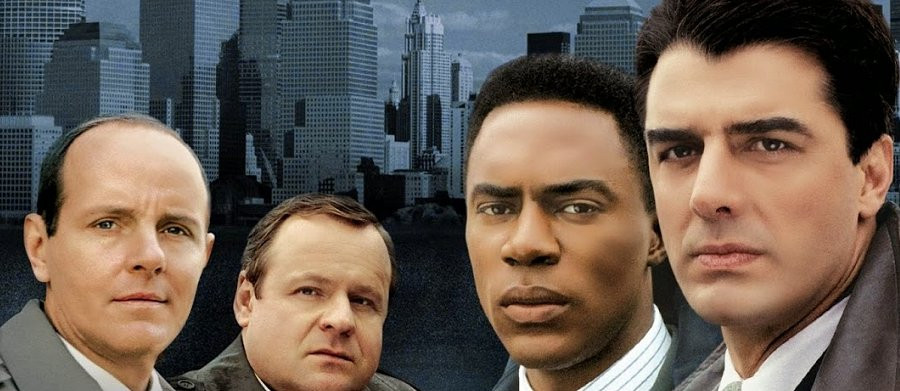
Jeeves and Wooster
1990 - United KingdomExcellent adaptation of the P.G. Wodehouse adventures of the dapper but dim-witted idle millionaire Bertie Wooster and his indispensable gentleman’s gentleman, the incomparable Jeeves, as played by Hugh Laurie and Stephen Fry in the roles that could easily have been written just for them.
Laurie had already perfected the role of a doltish buffoon in the BBC sitcom Blackadder and both stars had just finished filming the final series Blackadder Goes Forth. His character of Lt. The Honourable George Colthurst St. Barleigh was, like Bertie, several raisins short of a fruitcake. Fry, on the other hand, left behind the imbecilic General Sir Anthony Cecil Hogmanay Melchett to go from an over-the-top, mad as a box of frogs performance, to one of considered subtlety.

Despite the BBC’s successful 1965 series The World of Wooster starring Ian Carmichael and Dennis Price, it is this Granada production for ITV that is arguably remembered as the definitive interpretation of Wodehouse’s work. And justifiably so. The performances of the comedy double-act were toned to perfection, allaying the fears of the Wodehouse Society about Fry and Laurie’s appropriateness for the parts when the series was first announced. Even the stars themselves were unsure if they were suitable for the roles and later revealed that they only agreed to the series as it was going to be made with or without them, and they felt that no one else would do the parts justice. Fry had been a long-term fan of P.G. Wodehouse and had even written a letter to the author himself before his death in 1975, which elicited a signed photograph that remains a much-treasured possession to this day. It is because of this devotion to Wodehouse that both actors become the living embodiment of Jeeves and Wooster.
Clive Exton’s scripts, which were generally drawn from three short Wodehouse stories, were evocative of the authors’ tone and style, far more so than any previous adaption on the small screen, in the cinema, or on radio. Thank You, Jeeves! (1936), an American production, was the first film to feature Jeeves and Bertie, with Arthur Treacher as Jeeves and David Niven as Bertie Wooster. Although it received critical plaudits, it was made as a B-movie and was not widely distributed, being played only as a second feature in selected American cities. It was not screened in the UK because the British government at that time imposed a strict quota on imported films, which meant that B-movies were not shown! It wasn’t until 1955 that the first British dramatisation appeared on the BBC’s Light Programme. Ring for Jeeves, starred Deryck Guyler as Jeeves and Ian Carmichael portrayed Bill, Lord Rowcester. It's unclear if Guyler lost his regional accent for the part.

Jeeves and Wooster did delightful justice to Wodehouse and not just in the portrayal of the central characters. The young Hooray-Henry’s of the 1920s English upper-crust are portrayed as bumbling incompetent chumps who have too much time on their idle hands, conniving and conspiring in odd and frivolous exploits for the purpose of jolly pranks and trivial wagers. Bertie is well connected with this set, although he is, to the exception of some of his other associates, a thoroughly decent chap. His main problem though is that he’s as naïve as a child who believes everything he hears, which lands him in all sorts of self-inflicted predicaments from which he then has to be extricated by the ever-suffering Jeeves.

Also causing Bertie grief are his bossy aunts, Agatha and Dahlia, both of who he is terrified of. Many of the programme's supporting roles – including Aunt Dahlia were played by different actors over the four series. Francesca Folan played two very different characters: Madeline Bassett in series one and Lady Florence Craye in series four. The character of Stiffy Byng was played by Charlotte Attenborough in series two and by Amanda Harris in series three and then by Attenborough again in series four. Richard Braine, who took over the role of Gussie Fink-Nottle in series three and four, also appeared as the conniving Rupert Steggles in series one. Honestly, it’s enough to send a chap round the bally bend!
Shot on film, production values were high throughout the 23 episodes with sumptuous looking location filming (including several episodes set in New York City) and a stellar cast that included Robert Daws, John Woodnutt, Michael Ripper, Martin Clunes, Niamh Cusack, John Savident, Jack Watling and Deddie Davies. The third series won a British Academy Television Award for Best Design for Eileen Diss. The final series won a British Academy Television Award for Best Graphics for Derek W. Hayes and was nominated for a British Academy Television Award for Best Drama Series; it also earned a British Academy Television Award for Best Original Television Music for Anne Dudley and a British Academy Television Award for Best Costume Design for Dany Everett. Granada clearly put a lot into the series and were rewarded not only in the sense of industry recognition but also by the reaction of viewers and critics who adored it. What ho!
Seen this show? How do you rate it?
Seen this show? How do you rate it?
Published on March 9th, 2023. Written by Laurence Marcus for Television Heaven.










